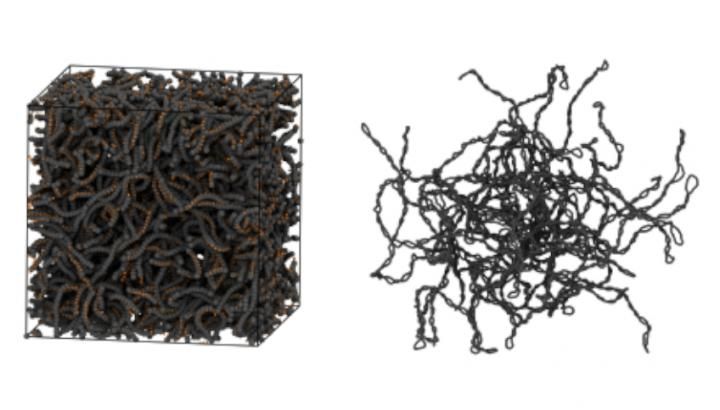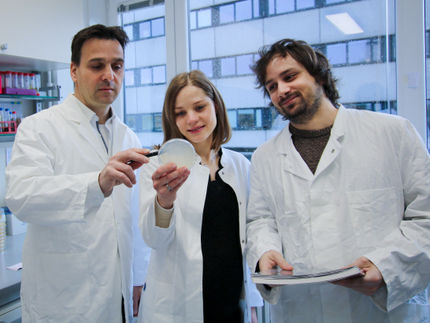DNA-based material with tunable properties
Potential applications in drug delivery and tissue regeneration
Advertisement
While DNA is often idealised as the "molecule of life", it is also a highly sophisticated polymer that can be used for next-generation materials. Beyond the fact that it can store information, further fascinating aspects of DNA are its geometric and topological properties, such as knotting and super-coiling. Indeed, very much like a twisted telephone cord, DNA is often found coiled up inside bacteria and other cells and even knotted in viruses. Now, a collaboration of scientists from the Universities of Edinburgh, San Diego and Vienna have started to harness these properties to craft "topologically tunable" DNA-based complex fluids and soft materials with potential applications in drug delivery and tissue regeneration as published in Science Advances.

On the left, a snapshot of the simulated system -- a dense solution of supercoiled plasmid. On the right, a more detailed view of the supercoiled fluid showing entanglements between the molecules.
© Davide Michieletto, University of Edinburgh and Jan Smrek, University of Vienna
The well-known double helical shape of DNA has profound implications on its behaviour. A linear DNA molecule, that is a DNA molecule with two ends, can freely twist and turn. By contrast, joining the two ends to form a DNA circle entails that any over or under twisting of the double-helix remains "topologically locked" i.e. the extra twist cannot be removed without cutting the molecule. Over or under twists have interesting consequences for how DNA molecules arrange in space — in particular, they coil and buckle onto themselves very much like an old telephone cord into so called supercoiled conformations (Fig. 1). The buckling of DNA relieves stress from the over/under twisting, and thereby decreases the overall size of the molecule. For this reason it is thought that supercoiling is a natural mechanism employed by cells to package their genome into tiny spaces. While the smaller size naturally leads to faster diffusion of DNA molecules in solution e.g. in water or through gel pores, because of the lower drag, this well-understood behaviour does not occur when many DNA molecules are packed and entangled like spaghetti in a bowl.
"We have performed large-scale computer simulations of dense solutions of DNA molecules with different degree of supercoiling and found several surprising results.", explains Jan Smrek from the University of Vienna, the first author of the study. "In contrast to the dilute case, the more super-coiled the DNA rings, the larger their size." Since the molecules need to avoid each other, their shapes adopt strongly asymmetric and branched conformations that occupy more volume than their non-supercoiled counterparts. Intriguingly, and contrary to expectations, "the larger DNA molecules still yield faster diffusion." The faster diffusion means that the solution has lower viscosity.
Supercoiled DNA molecules occurring naturally in bacteria are known as plasmids. In vivo, cells have special proteins called topoisomerase that can reduce the amount of supercoiling in plasmids. "Thanks to these proteins — which can be purified and used in the lab — we are able to control the extent of supercoiling in entangled DNA plasmids and study their dynamics using fluorescent dyes. We were amazed to discover that, indeed, DNA plasmids that were treated with topoisomerase, and hence with low supercoiling, are slower than their highly supercoiled counterparts." explains Rae Robertson Anderson, who led the experiments at the University of San Diego.
To explain the surprising faster dynamics the scientists used large scale simulations on supercomputers to quantify how entangled the molecules in solutions are. While it is known that a ringshaped polymer — rather similar to a circular DNA plasmid — can be threaded by another ring, meaning that the latter can pierce through the eye of the former, it was not known how this type of entanglement impacts the motion of supercoiled DNA. Thanks to the simulations, the scientists found that a high degree of supercoiling decreases the penetrable area of each molecule resulting, in turn, in fewer threadings between the plasmids and ultimately yielding a solution with lower viscosity. Nevertheless, the plasmids could still wrap around one another and constrain each others’ motion without threading. Yet, the supercoiling stiffens the conformations and thereby making them less prone to bend and entwine tightly, which reduces this type of entanglement too.
Davide Michieletto from the University of Edinburgh concludes, "not only did we find these novel effects in simulations, but we also demonstrated these trends experimentally and developed a theory describing them quantitatively. By changing the supercoiling we can tune the viscosity of these complex fluids at will. We now understand much better the connection between the adaptive geometry of the molecules and the resulting material properties. This is not only exciting from the fundamental perspective, but also promises useful applications. Using dedicated enzymes, such as the topoisomerase, one can design switchable DNA-based soft materials with tunable properties."

























































